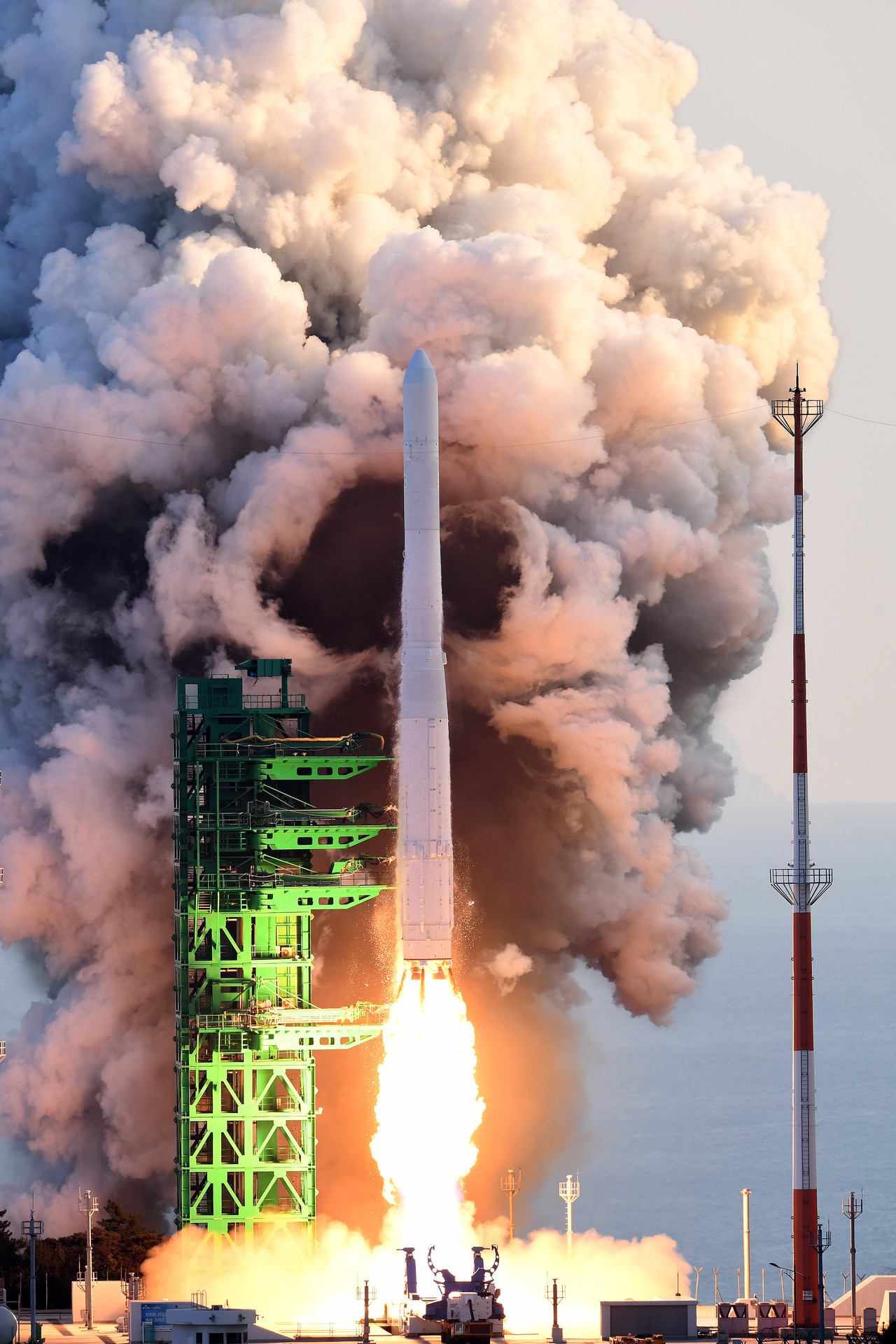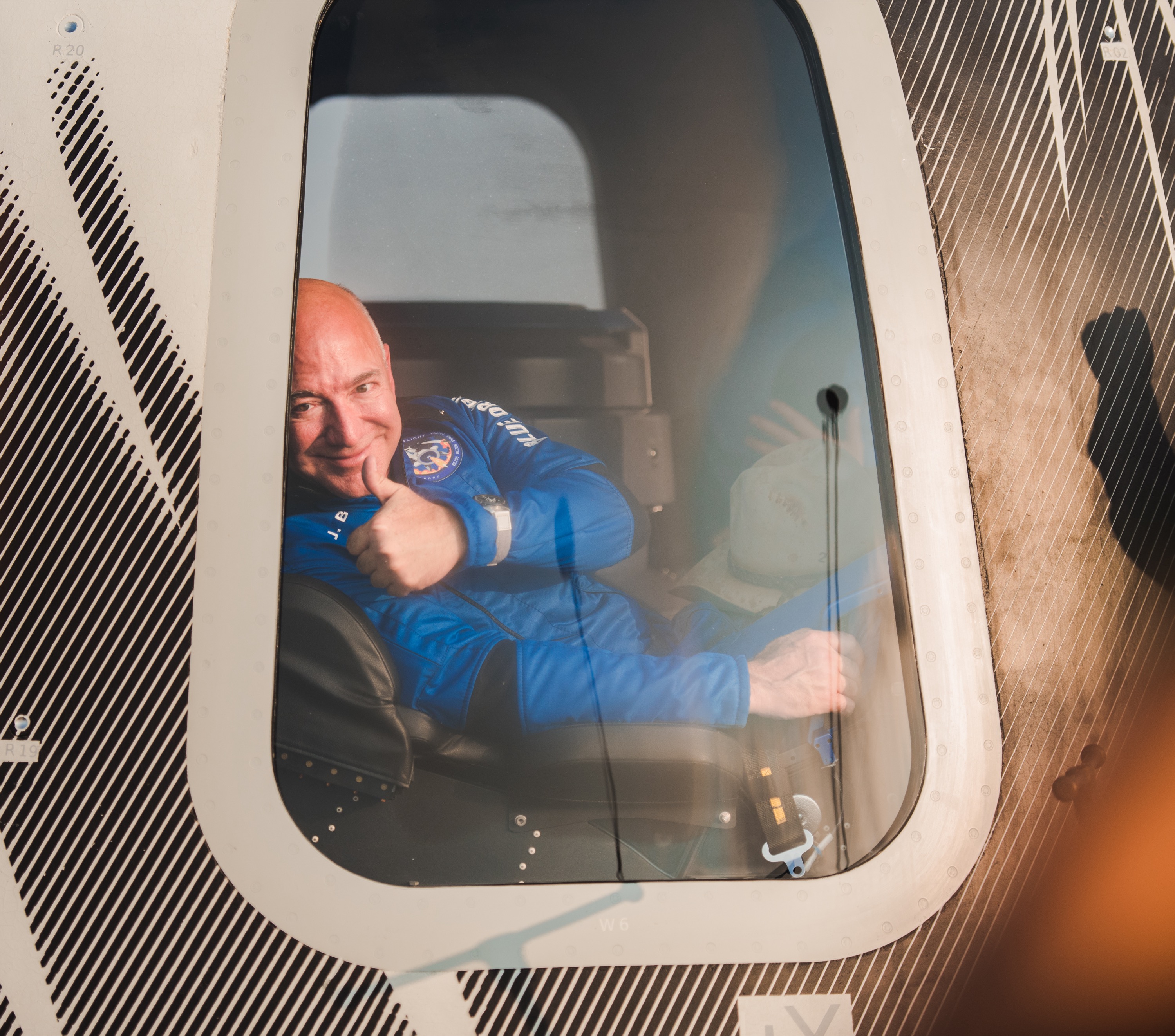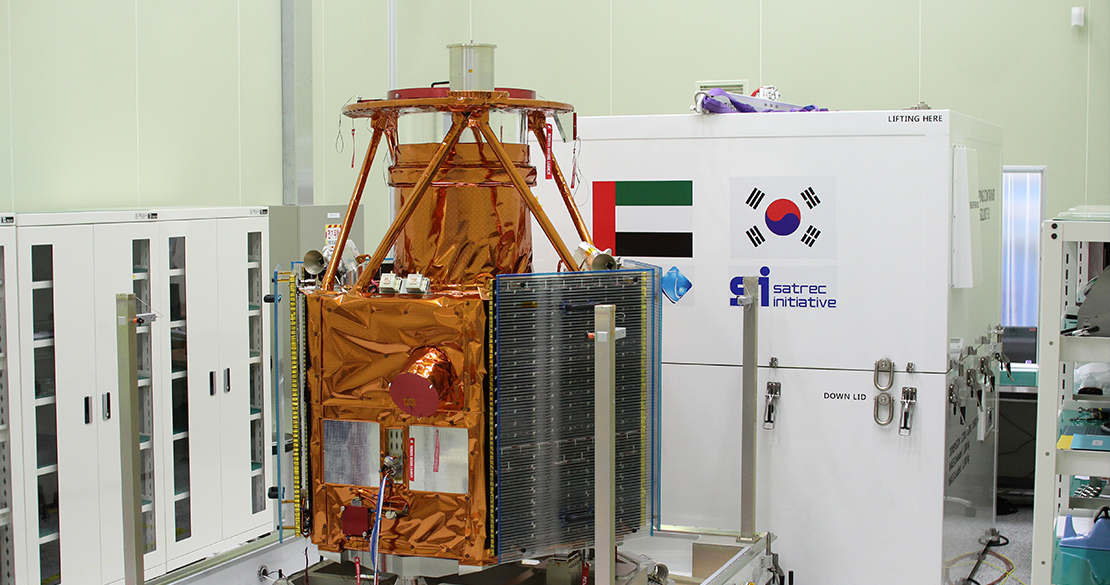2021: A NEW SPACE ODYSSEY
 ▶The first test launch of Korea Space Launch Vehicle-II was held in Naro Space Center on Oct. 21, 2021. © Korea Aerospace Research Institute
▶The first test launch of Korea Space Launch Vehicle-II was held in Naro Space Center on Oct. 21, 2021. © Korea Aerospace Research Institute
From the aerospace industry, the game-changing issue has been handed down in the year 2021. On Oct. 21, the first test launch of the first homegrown space rocket named Korea Space Launch Vehicle-II (KSLV-II), also known as Nuri, was carried out in Naro Space Center located in Goheung-gun, Jeollanam-do. The Nuri space rocket separated the first and second stage engines and ignited one after another, and then the third stage engine rose to its target altitude. The independent development in Korea was not the issue that has been easily accessible in the aerospace fields. In other words, the game is changing and the transition to the new paradigm is in process.
In
this sense, The Sogang Herald explains why Korean society is
participating in the space industry, portrays what movements there have been
and will be proceeding, and points out the factors that our society should
consider with a focus on the term New Space.
Korea
The
history of space development in Korean society began 30 years ago in 1992 by
launching the ultra-small satellite named Korea Institute of Technology
Satellite (KITSAT-1), also known as Uribyeol-1, from French Guiana
with the help of British researchers. Then the satellite communication era
began in Korea by launching Koreasat 1, 2, and 3, also
known as Mugunghwa, respectively in 1995, 1996, and 1999. In the case of
space launch vehicles, it began with the Korea Sounding Rocket (KSR),
launched for scientific observations and experiments from 1993 to 2002. Then
the KSLV-I, also known as Naro, launched with the Russian
aerospace company for satellite launches from 2009 to 2013, and now the
aforementioned KSLV-II project is in process. Nowadays, the development
of the space industry is playing an important role in society and enhancing the
quality of life from a very far but close distance. For instance, the Mugunghwa
satellites have allowed telecommunication and live broadcasting coverages and
the Communication, Ocean and Meteorological Satellites (COMS), also
known as Chollian, have allowed observations of weather, ocean,
atmosphere, etc.
The
status quo of Korean space development is heavily led by the government,
centered on the Ministry of Science and ICT (MSIT)[1]
and the National Space Commission[2]
based on the Space Development Promotion Act[3].
The goals of the Korean government can be found in the 3rd Basic
Plan for Space Development[4]
for 2018 to 2040. Among the six key strategies of the plan, the sixth strategy
of “Fostering the Space Industry and Creating Space Jobs” considers the above
mentioned “New Space” paradigm by aiming the expansion of the space industry
market, innovating through the creation of new industries, strengthening the global
competitiveness of space enterprises, and expanding the foundation for space
industry innovation as detailed goals.
New Space
 ▶Blue Origin had the spaceflight debut on July 20, 2021 with people on board including the founder Jeffrey Bezos via the launch vehicle New Shepard. © Blue Origin
▶Blue Origin had the spaceflight debut on July 20, 2021 with people on board including the founder Jeffrey Bezos via the launch vehicle New Shepard. © Blue Origin
Space
development projects in the past have been led by the government for military,
security, and enhancement of national prestige. The renowned National
Aeronautics and Space Administration (NASA), well-known for countless projects
such as the Apollo Program or space shuttles, is an independent agency of the
federal government directly responsible to the President of the United States
as its name begins with “National”. In Korea, although it is not an independent
government body, the government-funded research institute under the MSIT named
Korea Aerospace Research Institute (KARI) has led and participated in projects.
This traditional system centered on the public side is often referred to as the
Old Space era.
However,
in the New Space era, the space development projects are also led by the
private sector, where the enterprises and investors participate with expectations
of profit and enlargement of the market. Hence, the purpose of the industry and
the projects shifted from the competition of national power like the case of
the Space Race between the United States and the Soviet Union during the Cold
War to prioritizing the criterion of cost and efficiency just like many other
markets. Instead of just showcasing their abilities and technologies to achieve
a sense of accomplishment and boost their patriotic ego, the companies are now
investing and inventing to actually earn more money while lowering the
production and launching costs of the rockets. For instance, Blue Origin and
SpaceX, each founded by the notorious entrepreneurs Jeffrey Bezos and Elon Musk
have been massively working and investing on technologies for reusing the
launch vehicles in order to save the launching cost and to promote relevant
programs such as the private sector’s spaceflight, cargo to the International
Space Station, and launching satellites including the companies’ very own
satellite internet constellations projects named Kuiper and Starlink.
Therefore, to survive in the New Space Race, the role of the private sector has
relatively been more significant than before as well as the government’s
carrots and/or sticks to appropriately foster the corporations.
The Korean New Space
 ▶Korean satellite manufacturer Satrec Initiative has cooperated with the United Arab Emirates' satellite projects such as the DubaiSat-2 of the picture. © Satrec Initiative
▶Korean satellite manufacturer Satrec Initiative has cooperated with the United Arab Emirates' satellite projects such as the DubaiSat-2 of the picture. © Satrec Initiative
The
New Space paradigm in Korean society may seem somewhat late and small compared
to other nations such as the United States or neighbor Japan, but it is not
invisible in Korea. The aforementioned KSLV-II is the representative
case that shows that Korean society is entering the era of New Space. Behind
the first launch of Nuri on Oct. 21, 2021, there were more than 300
local enterprises and institutes participating in the first independently
developed launch vehicle of Korea. According to KARI, not only the major
companies such as Korea Aerospace Industries (KAI) and Hanwha Aerospace of the
conglomerate Hanwha Group and Hyundai Heavy Industries of the conglomerate
Hyundai Group, but also the small and medium-sized businesses such as Space
Solution based in Seoul and DACC Aerospace based in Waju-gun, Jeollabuk-do
joined the project. While the major companies focused on more massive parts
such as system assembly, propulsion units and engines, and aerodynamics based on
their capital power, the small and medium-sized enterprises were said to have
contributed to increasing profitability by supplying components.
Moreover,
Hanwha Group launched Space Hub as the conglomerate’s space industry control
tower and jointly established a space research center with KAIST with the
satellite communication technology field to process high-capacity data with a
speed. In addition, its affiliates are actively investing in existing space
industry enterprises. For instance, Hanwha System invested an estimated ₩ 345 billion in OneWeb, a leading company in
high-speed space Internet services, and has set up an ambitious goal of
launching its very own communication satellite by 2025. Similarly, Hanhwa
Aerospace invested an estimated ₩108.9 billion
in world-leading Korean small satellite manufacturer Satrec Initiative. KAI
has also formed the New Space Task Force earlier this year and is building a
private space center in Sacheon-si, Gyeongsangnam-do, where the procedures of
designing, manufacturing, assembly, and testing would be conducted in one
integrated area. Based on the recent experience with KSLV-II, KAI aims
to specialize in launch vehicles and satellites fields, and even enter overseas
with the investment of ₩ 2.2 trillion to
have the nations in Southeast Asia and the Middle East that are not capable of
rocket launches as their customers.
Naturally,
the New Space is heavily led by the private sector, but that does not mean that
the government is absent. The government can participate in the New Space by
providing opportunities and infrastructures for the private companies to
participate. In fact, the Korean government is also doing so. For instance,
according to the results of the National Space Commission in June, the Ministry
of Science and ICT decided to push for the development and launch of small
vehicles based on solid fuel by 2024. In the case of solid fuel launch
vehicles, it was announced that the projects would be led by private industries
considering that the mechanical structure and necessary launch site facilities
are relatively simpler than liquid fuel vehicles. In addition, a launch site
available to the private sector will be built in the Naro Space Center. The new
launch site mainly for solid fuel launch vehicles will be built by 2024 while
the additional general-purpose launch sites for diverse fuels would be prepared
by 2030.
Galaxy Quests
Since
the New Space paradigm is just getting started in Korean society, obviously
there are some tasks ahead that our society must resolve. First of all, plans
and support on a continuous and stable scale are needed. To expect remarkable
and tremendous changes and innovations, it seems necessary to establish the
plans in the long term. The companies and institutions working on development,
the government fostering and funding the companies and institutions, and the
investors who enable the existence of the companies and institutions must also
not fluctuate between good and bad easily. The projects should not be suspended
or even canceled easily but rather be viewed in the long-term. Even with the
cases of Naro and Nuri, there were a series of failures and
hardships behind the achievements like the first two launches of Naro,
and those experiences became the opportunities to learn lessons and improve on
flaws. Hence, the space development-related works should be evaluated and
supported in a long-term, rather than a one-and-done perspective. Additionally,
for the government, which was the main player in space development, to transfer
technologies and know-how to the private sector, the opportunities should be
given continuously and repeatedly rather than simply conducting a one-time
show-off event.
Furthermore,
as mentioned earlier in the 3rd
Basic Plan for Space Development’s aim to strengthen the space enterprises’
global competitiveness, cooperating with overseas companies to expand profits
without lagging is necessary. Just like KAI’s case of signing a partnership
with the private aerospace manufacturer SpaceX across the Pacific Ocean and
also aiming to enter overseas markets in Southeast Asia and the Middle East,
expanding the scope worldwide could be an opportunity for the companies. Firms
could get help where their abilities do not reach or reduce cost. Also, profits
could be pursued in places where the local space industry is comparatively
lagging. Similar cases already existed in the past like the exemplar of Satrec
Initiative exporting satellites to diverse nations such as Malaysia and the
United Arab Emirates since more than a decade ago. Hence, the feasibility of
this task to expand worldwide would be more than impossible.
Reminder
The
launch of Nuri, the first homegrown launch vehicle made after the
cooperation of more than 300 Korean corporates and enterprises, has signaled
the Korean society’s advance into New Space as the private sector is on the
verge of taking charge. Companies on the frontier of the New Space paradigm are
already showing innovative and positive outputs that the commercialization in
space development can induce. Considering the expected expansion of
infrastructure for the private sectors like the new private launch site coming
in 2024, more opportunities and better environments would welcome the private
sector. Therefore, The Sogang Herald recommends the Sogangers to
consistently witness the process of the upcoming Korean New Space paradigm with
the space development in the long-term perspective as it might change entire
lives like how the satellites did with telecommunications or
broadcasting.
By
Jeon Kun-hee (Int'1 & Social Reporter)
dkhjeon@sogang.ac.kr
